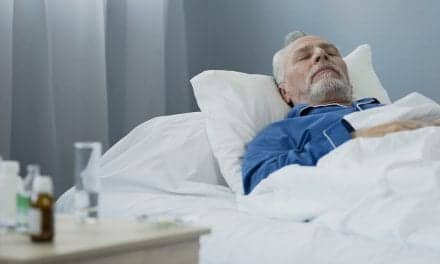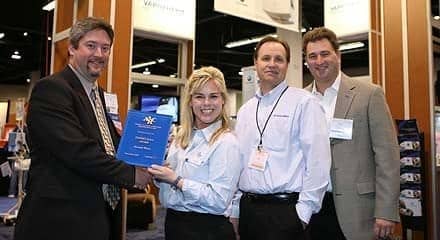Obstructive sleep apnea is a potentially life-threatening sleep disorder that affects 20% to 30% of older adults. Management of OSA requires accurate diagnosis and appropriate treatment

Primary sleep disorders that may be diagnosed through polysomnography include obstructive sleep apnea (OSA), restless legs syndrome (RLS), and periodic limb movement disorder (PLMD). Primary sleep disorders may delay sleep onset, cause multiple arousals and awakenings, and promote excessive daytime sleepiness. In elderly patients with primary sleep disorders, wandering behavior and confusional arousals may occur, particularly in patients with dementing disorders. Optimal management of primary sleep disorders is predicated on an understanding of underlying causes, accurate diagnosis, and the institution of appropriate treatment.
OSA Characteristics
OSA is a common, yet underrecognized disorder that affects approximately 4% of middle-aged adults and 20% to 50% of elderly people.3,4 Of the approximately 75,000 patients seen annually in US sleep-disorder centers, roughly 75% are diagnosed with OSA.5 Projections of the prevalence of OSA in the United States range from 7 to 18 million.5,6
OSA is a potentially life-threatening condition characterized by repeated collapse of the upper airway during sleep, cessation of breathing, and clinical associations with a variety of disease states. The spectrum and severity of clinical presentations of OSA are extremely variable.
The reduction caused by sleep in the tonic muscle activity that dilates the upper airway is associated with reduced upper-airway caliber and increased pharyngeal-wall compliance.7 The mechanical corollary of decreased caliber is an increase in upper-airway resistance.8 In addition, greater pharyngeal-wall compliance during sleep (in snorers) is manifested by the occurrence of inspiratory flow limitation, seen as the flow reaches its plateau during inspiration. The combination of increased resistance and inspiratory flow limitation leads to increased work of breathing, hypoventilation, and frequent arousals from sleep (with ensuing excessive daytime sleepiness). This has been described as a distinct clinical entity: upper-airway resistance syndrome.9
|
||||||||||||||||||
Nasal continuous positive airway pressure (CPAP) is the initial treatment of choice for OSA in adults and can reduce mortality associated with OSA.10 CPAP allows progressive restoration of airflow, since the pressure applied exceeds the airway-opening pressure. Appropriate CPAP use can resolve OSA in many patients. CPAP works by pneumatically splinting the collapsible upper airway. Although effective, CPAP is uncomfortable or intolerable for some patients, and variable patient compliance remains a significant problem. Studies have found that up to 25% of patients discontinue CPAP therapy.11,12
Behavioral modifications that may be useful in patients with OSA include avoidance of alcohol and sedative medications, alteration of sleep position, avoidance of sleep deprivation, and weight loss. Drug therapy for OSA is of limited clinical value, with the exception of thyroxine replacement in patients with hypothyroidism.
Polysomnographic Parameters and Uses
Typically, polysomnographic assessment requires at least four neurophysiological channels: an electroencephalogram (EEG) channel to monitor sleep stage, two electrooculogram channels to monitor eye movements during sleep; and one electromyogram (EMG) channel to record muscle tone.13 Additional polysomnographic parameters may include more EEG and EMG channels, airflow, electrocardiography, pulse oximetry, respiratory effort, and sound recordings used to measure snoring.13.14 Optional polysomnographic parameters include continuous video monitoring of body positions, core body temperatures, penile enlargement, and pressure and pH at various esophageal levels.13,14
|
The American Academy of Sleep Medicine (AASM) has established the major uses of polysomnography (Table 1). According to the AASM, polysomnography is useful for the evaluation of insomnia associated with sleep-related breathing disorders, when the initial diagnosis is uncertain, and when behavioral or pharmacological treatment fails.1 Additional diagnostic categories for which polysomnography may play a useful role include respiratory disorders other than sleep-related breathing disorders, narcolepsy, parasomnias, sleep-related seizure disorders, and circadian-rhythm sleep disorders (Table 2).2 Polysomnography is not routinely used to diagnose chronic lung disease.
Because polysomnography is expensive and requires an overnight stay at a sleep center, some investigators have assessed the clinical utility of other procedures in the diagnosis of OSA. In a prospective study,15 investigators compared the accuracy of polysomnography with that of home oximetry in predicting which of 288 patients with OSA had symptoms that would improve with treatment. Patients with OSA were treated for 4 weeks with auto-adjusting CPAP. Success was defined as an increase of more than 1 point on the Sleep Apnea Quality of Life Index. Correct prediction rates were compared. The researchers noted a correct prediction rate of 0.61 for polysomnography and 0.64 for home monitoring (P>.05). They concluded that the ability to predict the outcome of CPAP treatment is not significantly better for polysomnography than for home oximetry.
Conclusion
Currently, polysomnography is the optimum test for diagnosing OSA and other sleep-related breathing disorders. It includes evaluation of sleep staging, airflow and ventilatory effort, oxygen saturation, body position, and periodic limb movements. Home oximetry may be a more convenient and less expensive alternative in patients with established OSA who are being monitored to assess the response to treatment.
References
1. Littner M, Hirshkowitz M, Kramer M, et al. Practice parameters for using polysomnography to evaluate insomnia: an update. Sleep. 2003;26:754-760.
2. Kushida CA, Littner MR, Morgenthaler T, et al. Practice parameters for the indications for polysomnography and related procedures: an update for 2005. Sleep. 2005;28:499-521.
3. Bixler EO, Vgontzas AN, Ten Have T, Tyson K, Kales A. Effects of age on sleep apnea in men: I. Prevalence and severity. Am J Respir Crit Care Med. 1998;157:144-148.
4. Mador MJ, Kufel TJ, Magalang UJ, Rajesh SK, Watwe V, Grant BJ. Prevalence of positional sleep apnea in patients undergoing polysomnography. Chest. 2005;128:2130-2137.
5. Scharf SM, Tubman A, Smale P. Prevalence of concomitant sleep disorders in patients with obstructive sleep apnea. Sleep Breath. 2005;9:50-56.
6. Seneviratne U, Puvanendran K. Excessive daytime sleepiness in obstructive sleep apnea: prevalence, severity, and predictors. Sleep Med. 2004;5:339-343.
7. Tangel DJ, Mezzanotte WS, White DP. Influence of sleep on tensor palatini EMG and upper airway resistance in normal men. J Appl Physiol. 1991;70:2574-2581.
8. Shepard JW, Pevernagie DA, Stanson AW, et al. Effects of changes in central venous pressure on upper airway size in patients with obstructive sleep apnea. Am J Respir Crit Care Med. 1996;153: 250-254.
9. Guilleminault C, Stoohs R, Clerk M, et al. A cause of excessive daytime sleepiness: the upper airway resistance syndrome. Chest. 1993;104:781-787.
10. He J, Kryger MH, Zorick FJ, et al. Mortality and apnea index in obstructive sleep apnea: experience in 385 male patients. Chest. 1988;94:9-14.
11. Reeves-Hoche MK, Meck R, Zwillich CW, et al. Nasal CPAP: an objective evaluation of patient compliance. Am J Respir Crit Care Med. 1994;149:149-154.
12. Waldhorn RE, Herrick TW, Nguyen MC, et al. Long-term compliance with nasal CPAP therapy of obstructive sleep apnea. Chest. 1990;97:33-38.
13. Nowack WJ. Polysomnography: overview and clinical applications. 2005. Available at: http://www.emedicine.com/neuro/topic566.htm Accessed April 30, 2006.
14. American Association of Respiratory Care-Association of Polysomnography Technologists. AARC-APT clinical practice guideline. Polysomnography. Respir Care. 1995;40:1336-1343.
15. National Sleep Dynamics Inc. Polysomnogram. Available at [removed]www.aa-studio.com/portfolio/nsdi/polysom.htm[/removed]. Accessed May 1, 2006.
16. Whitelaw WA, Brant RF, Flemons WW. Clinical usefulness of home oximetry compared with polysomnography for assessment of sleep apnea. Am J Respir Crit Care Med. 2005;171:188-193.
FOR FURTHER READING
Association of Polysomnographic Technologists. Welcome to the APT. Available at: http://www.aptweb.org. Accessed April 30, 2006.
John D. Zoidis, MD, is a contributing writer for RT.









